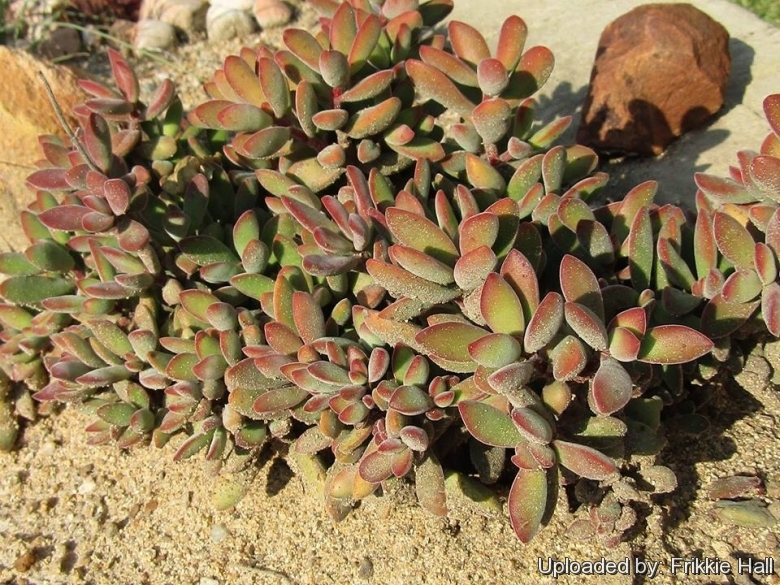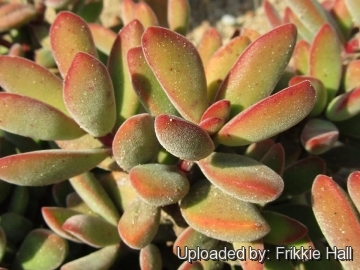Accepted Scientific Name: Crassula rogersii Schönland
Rec. Albany Mus. 2: 149 1907

Globulea rogersii (Crassula rogersii) Photo by: Frikkie Hall
Origin and Habitat: Crassula rogersiiSN|27403]]SN|27403]] is endemic to South Africa in the Eastern Cape (Province from Willowmore to Port Elizabeth and Port Alfred)
Habitat and ecology: Dry river valleys in Albany thicket and Succulent Karoo, among rocks and scrub.
Synonyms:
See all synonyms of Crassula rogersii
back
Accepted name in llifle Database:Crassula rogersii SchönlandRec. Albany Mus. 2: 149 1907Synonymy: 3
back
Common Names include:
CHINESE (中文): 若歌诗
Description: Crassula rogersiiSN|26686]]SN|27403]] is a small, much-branched, decumbent to erect succulent bush with fleshy red stems and club-shaped leaves. The leaves are covered with short white hairs giving them a velvety appearance and a felt-like texture. In its natural habitat, Crassula rogersiiSN|27403]]SN|27403]] forms a small, tight cushion to 15-30 cm tall. The plant remains green in shady spots but is at its best with plenty of sunlight, where the leaves become tipped with red. The tiny star-shaped flowers are yellow, and are held in small clusters at the end of thin stems from mid-summer to autumn. There are several hybrids of this plant.
Derivation of specific name: This member of the Crassulaceae family was given this name by Frederick A. Rogers (1876- 1944), English missionary and amateur botanist, lived in Republic of South Africa from 1904.
Roots: Fibrous.
Branches: Succulent, erect and later decumbent, green, older brancheas becoming woody and reddish-brown, 3.5-5 mm in diameter, old leaves not persistent.
Leaves: Opposite, oblanceolate to club-shaped or sub-semi-cylindrical, 15-23 mm long, 7-13 mm broad, flattened, ascending and twisted sideways, hairy, both faces convex, green to yellowish green, margin reddish, horny, base cuneate, tip obtuse to rounded. Hairs fine, soft, and white.
Inflorescence: Elongated thyrses to 20 cm long, with several globular dichasia (clusters).
Flowers. Pale yellow. Sepals triangular, to 2.5 mm long, obtuse, margin ciliate. Corolla tubular, yellowish, the petals to 4 mm long, fused shortly at the base and with ovoid dorsal appendage. The anthers are dark brown.
Blooming season: Flowers mid-summer to autumn.
Similar species: Crassula rogersiiSN|27403]]SN|27403]] is easily confounded with hairy forms of Crassula cultrataSN|27403]]SN|26686]], but has smaller leaves which are convex below. The two species when occurring together are distinct and C. cultrata appears to be much more erect and (usually) glabrous.
Bibliography: Major references and further lectures
1) Urs Eggli “Illustrated Handbook of Succulent Plants: Crassulaceae” Springer Berlin Heidelberg, 05/Nov/2012
2) Doreen Court “Succulent Flora of Southern Africa” CRC Press, 01/Jun/2000
3) Hermann Jacobsen “Abromeitiella to Euphorbia” Blandford Press, 1960
4) Urs Eggli, Leonard E. Newton “Etymological Dictionary of Succulent Plant Names” Springer Science & Business Media, 11 March 2004
5) Crassula rogersii at: kumbulanursery.co.za - Kumbula Indigenous Nursery A database of Indigenous South African Flora <http://kumbulanursery.co.za/plants/crassula-rogersii>
 Globulea rogersii (Crassula rogersii) Photo by: Frikkie Hall
Globulea rogersii (Crassula rogersii) Photo by: Frikkie Hall The leaves are covered with short white hairs giving them a velvety appearance and a felt-like texture. (Crassula rogersii) Photo by: Frikkie Hall
The leaves are covered with short white hairs giving them a velvety appearance and a felt-like texture. (Crassula rogersii) Photo by: Frikkie HallCultivation and Propagation: Crassula rogersiiSN|27403]]SN|27403]] develops into a small, dense cushion but does not seem to spread, making it particularly useful for pot cultivation or nooks in a rockery. Like most succulents, become very attractive and highly coloured when grown in shallow containers and exposed to all weather conditions, but for rapid growth good rich soil is necessary.
Exposition: It does best in bright light with some morning- and/or evening sun. A half shaded place will be tolerated. Afternoon sun and high heat in summer can cause the leaves become tipped with red.
Water: Drench the soil well, water running out of the pot’s hole must be removed after a few minutes. Wet legs can cause rotten roots. Before adding water next allow to dry.
Pests and bugs: Crassulas are sensitive to mealybugs. Large clumps of Crassula rogersiiSN|27403]]SN|27403]] should be lifted and divided in the winter to prevent the clumps from rotting.
Propagation: Leaf cuttings, offsets.












